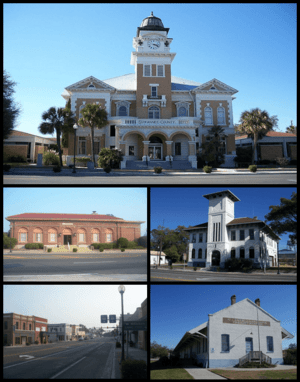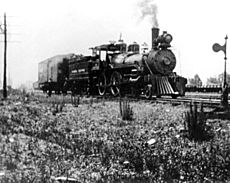Live Oak, Florida facts for kids
Quick facts for kids
City of Live Oak
|
||
|---|---|---|
| Live Oak, Florida | ||

Suwannee County Courthouse, Old Post Office, Old Live Oak City Hall, Downtown Live Oak, ACL Freight Station
|
||
|
||
| Nickname(s):
The City of Nature
|
||
| Motto(s):
"A Caring Community"
"Heart of the Suwannee River Valley" "In God We Trust" |
||

Location in Suwannee County and the state of Florida
|
||
| Country | ||
| State | ||
| County | Suwannee | |
| Incorporated (town) | 1878 | |
| Incorporated (city) | 1903 | |
| Government | ||
| • Type | Mayor–Council | |
| Area | ||
| • Total | 7.63 sq mi (19.76 km2) | |
| • Land | 7.63 sq mi (19.76 km2) | |
| • Water | 0.00 sq mi (0.01 km2) | |
| Elevation | 105 ft (32 m) | |
| Population
(2020)
|
||
| • Total | 6,735 | |
| • Density | 882.82/sq mi (340.87/km2) | |
| Time zone | UTC-5 (Eastern (EST)) | |
| • Summer (DST) | UTC-4 (EDT) | |
| ZIP codes |
32060, 32064
|
|
| Area code(s) | 386 | |
| FIPS code | 12-40875 | |
| GNIS feature ID | 0285862 | |
| Website | www.cityofliveoak.org | |
Live Oak is a city and the county seat of Suwannee County, Florida, United States. The city is midway between Tallahassee and Jacksonville. As of 2020, the population recorded by the U.S. Census Bureau was 6,735.
U.S. Highway 90, U.S. Highway 129 and Interstate 10 are major highways running through Live Oak.
Freight service is provided by the Florida Gulf & Atlantic Railroad, which acquired most of the former CSX main line from Pensacola to Jacksonville on June 1, 2019.
It is served by the Suwannee County Airport as well as many private airparks scattered throughout the county.
There is also a community named Live Oak in Washington County, Florida.
History
The founding of Live Oak dates back to shortly before the Civil War. Established in 1858, Live Oak was located at a junction between two strategically important railways: one operating between Jacksonville and Tallahassee, and another running south from Dupont, Georgia. A large live oak tree located off the railways was a gathering and resting spot for many of the workers on the line, and gave the new cityscape its name. The tree was formerly located where the now-present Pepe's Mexican Grocery on U.S. 90 is located.
In 1879, the state legislature founded a normal school for blacks for the training of teachers; it developed as Florida Memorial University, now based in Miami.
Geographically, Suwannee County is situated on a limestone bed riddled with underground freshwater streams, which surface in dozens of beautiful springs. This phenomenon of "Karst topography" gives the area a local supply of renewable fresh water and abundant sources of fishing. The county is known as a world-class cave diving site for SCUBA enthusiasts, and underwater cave explorer Sheck Exley chose to live here in order to have close access to many of the springs.
The Twin Rivers State Forest is a 14,882-acre (60 km2) Florida State forest located in North Central Florida, near Live Oak.
Geography
Geographically, Suwannee County is situated on a limestone bed riddled with underground freshwater streams, which surface in dozens of beautiful springs. This phenomenon of "Karst topography" gives the area a local supply of renewable fresh water and abundant sources of fishing. The county is known as a world-class cave diving site for SCUBA enthusiasts, and underwater cave explorer Sheck Exley chose to live here in order to have close access to many of the springs.
Fishing sites include a number of small lakes about 5 miles east of the town. Suwannee Lake is the most well stocked and notable, but there is also Workman Lake, Dexter Lake, Campground Lake, Little Lake Hull, White Lake, Tiger Lake, Bachelor Lake, and Peacock Lake.
The Twin Rivers State Forest is a 14,882-acre (60 km2) Florida State forest located in North Central Florida, near Live Oak.
Climate
Live Oak receives rain, on average, 84 days per year. This makes it the city that receives the fewest days of rain per year over 0.1 inches in Florida.
Demographics
| Historical population | |||
|---|---|---|---|
| Census | Pop. | %± | |
| 1880 | 458 | — | |
| 1890 | 687 | 50.0% | |
| 1900 | 1,659 | 141.5% | |
| 1910 | 3,450 | 108.0% | |
| 1920 | 3,103 | −10.1% | |
| 1930 | 2,734 | −11.9% | |
| 1940 | 3,427 | 25.3% | |
| 1950 | 4,064 | 18.6% | |
| 1960 | 6,544 | 61.0% | |
| 1970 | 6,830 | 4.4% | |
| 1980 | 6,732 | −1.4% | |
| 1990 | 6,332 | −5.9% | |
| 2000 | 6,480 | 2.3% | |
| 2010 | 6,850 | 5.7% | |
| 2020 | 6,735 | −1.7% | |
| U.S. Decennial Census | |||
| Race | Pop 2010 | Pop 2020 | % 2010 | % 2020 |
|---|---|---|---|---|
| White (NH) | 3,192 | 3,026 | 46.60% | 44.93% |
| Black or African American (NH) | 2,361 | 2,079 | 34.47% | 30.87% |
| Native American or Alaska Native (NH) | 15 | 26 | 0.22% | 0.39% |
| Asian (NH) | 67 | 97 | 0.98% | 1.44% |
| Pacific Islander or Native Hawaiian (NH) | 2 | 5 | 0.03% | 0.07% |
| Some other race (NH) | 1 | 33 | 0.01% | 0.49% |
| Two or more races/Multiracial (NH) | 103 | 253 | 1.50% | 3.76% |
| Hispanic or Latino (any race) | 1,109 | 1,216 | 16.19% | 18.05% |
| Total | 6,850 | 6,735 | 100.00% | 100.00% |
As of the 2020 United States census, there were 6,735 people, 2,450 households, and 1,401 families residing in the city.
The population density in 2020 was 882.8 inhabitants per square mile (340.9/km2). There were 2.60 persons per household.
By age, the population in 2020 was split with 3.8% under 5 years old, 20.1% under 18 years old, and 17.3% 65 years and older. 49.6% of the population were female born persons.
In 2020, there was an owner-occupied housing unit rate of 48.2%. The median value of owner-occupied housing units was $104,400. The median selected monthly owner costs -with a mortgage was $1,121 and -without a mortgage was $374. The median gross rent was $773. 58.0% of households had a computer and 64.7% of households had a broadband internet subscription. The median household income was $45,417. There was a per capita income of $21,402. 26.2% of the population lived below the poverty threshold.
In 2020, 88.8% of the population 25 years and older were high school graduates or higher and 15.5% of that same population had a Bachelor's degree or higher.
As of the 2010 United States census, there were 6,850 people, 2,345 households, and 1,620 families residing in the city.
Library
History
The City of Live Oak is the headquarters for the Suwannee River Regional Library System.
Live Oak had a small town library up until the 1940s, which was financed by the County with $25 a month. This first library was a small wooden structure located on the corner of Pine and Wilbur, originally used as the public restrooms for white women.
In 1948, a library annex was included in the building expansion program by the Board of County Commissioners. This building was made of brick and housed the public restroom for white women, a draft board office, and the library. The draft board office and library shared space and personnel until the Fall of 1954. In October 1954, half a million dollars was budgeted by the County Commissioners, and the City Council approved $500 annually for the operation of the Suwannee County Free Library.
The library opened on February 28, 1955, and had a collection of 3,100 books, some of which they borrowed from the State Library. Mrs. Sara Rogers became the first librarian after resigning her position as Chairman of the Woman’s Club Library Project Committee. Rogers resigned on April 6, 1956, to become postmistress, and was succeeded by Mrs. W.D. Richardson on March 15, 1957.
In an effort to receive federal funds, the Suwannee Board convinced Lafayette County to join in a regional library cooperative in 1957. In 1958, the first regional library system was established in Florida, servicing Lafayette and Suwannee counties.
By 1958, the library's collection had grown from 3,100 books to 10,000, and a bookmobile was established. In 1959, the regional library system grew to include seven different counties. On July 20, 1959, the Suwannee River Regional Library Board hosted the five incoming counties who all officially joined October 1, 1959. In 1960, the main library was located in Live Oak, with eight local units, consisting of over 23,500 books. The Miami Public Library gave 3,000 of those as a gift. The start of construction on the new Suwannee River Regional Library on Ohio Avenue South began on January 4, 1996, and the new building was dedicated on November 24, 1996. At that time, students included a time capsule to be opened on December 16, 2045, during Florida’s Bicentennial.
Awards
In April 1960, the Book-of the-Month Club awarded the Suwannee River Regional Library with the Dorothy Canfield Fisher Award. In the U.S., there were only eight rural libraries to qualify and receive the award, and the Suwannee River Regional Library was the only one from the south to be nominated and win the $1,000 prize.
On April 7, 1992, the Suwannee County Commission signed a resolution honoring the people responsible for the library’s thirty-five years of operation.
In 2009, the Suwannee River Regional Library was one of two-hundred and eight nationwide institutions to win a Big Read grant and The Maltese Falcon was chosen as the book to highlight. The library hosted a 1930s themed kick-off party on February 5, 2009 that turned into a monthlong "whodunit" when the model display Maltese Falcon was disappeared during festivities. The library used the grant to start a tween book club and created programs for middle and high school students including podcasts, art projects, and a film noir marathon. The library distributed three-hundred copies of The Maltese Falcon to the community with additional copies going to the high school and eleven life-size cut-outs of Humphrey Bogart as Sam Spade were distributed throughout town to garner interest.
See also
 In Spanish: Live Oak (Florida) para niños
In Spanish: Live Oak (Florida) para niños



